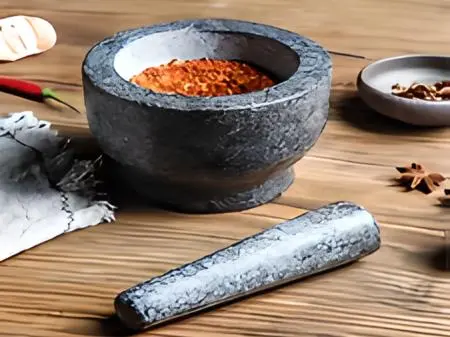Does Stone Spice Grinder Preserve Spice Aromas Better?
2025-07-17 18:55:05

When it comes to preserving the rich aromas of spices, the Stone Spice Grinder reigns supreme. This ancient tool, also known as a mortar and pestle, has been a staple in kitchens worldwide for centuries, and for good reason. The natural properties of stone, combined with the manual grinding action, create the perfect environment for releasing and maintaining the volatile oils responsible for a spice's distinctive scent and flavor. Unlike electric grinders that can heat spices and cause aroma loss, the Stone Spice Grinder keeps spices cool during the grinding process, ensuring that delicate aromatics remain intact. The porous surface of stone also helps to trap these essential oils, allowing for a more intense and long-lasting aroma. Whether you're crushing peppercorns, grinding coriander seeds, or creating a complex spice blend, a high-quality stone grinder can significantly enhance the olfactory experience of your culinary creations. Let's delve deeper into the science and benefits behind this time-honored kitchen tool.
Do Granite Mortar and Pestle Really Enhance Spice Flavors? The Science Explained
The efficacy of granite mortar and pestle in enhancing spice flavors is not just culinary lore; it's backed by scientific principles. When spices are ground using a stone implement, several key processes occur that contribute to flavor enhancement:
Mechanical Cell Rupture
The abrasive surface of granite, combined with the pressure applied during grinding, effectively ruptures the cell walls of spices. This mechanical breakdown releases volatile compounds and essential oils that are otherwise trapped within the cellular structure. These compounds are responsible for the characteristic flavors and aromas we associate with various spices.
Temperature Control
Unlike electric grinders that can generate heat through friction, potentially damaging heat-sensitive compounds, stone grinders maintain a relatively cool temperature during the grinding process. This temperature stability preserves the integrity of delicate flavor molecules, ensuring that the full spectrum of a spice's taste profile remains intact.
Surface Area Expansion
The grinding action in a mortar and pestle significantly increases the surface area of spice particles. This expanded surface area allows for greater interaction between the spice compounds and our taste buds, resulting in a more pronounced and nuanced flavor experience.
Oxidation Minimization
The controlled, manual nature of grinding with stone tools minimizes exposure to air, reducing oxidation of sensitive flavor compounds. This preservation of freshness contributes to a more vibrant and true-to-source taste.
These scientific factors collectively demonstrate why a granite mortar and pestle, like our Stone Spice Grinder, can indeed enhance spice flavors in ways that modern electric grinders cannot replicate.
The Ancient Advantage: Why Stone Grinders Outperform Metal for Aroma
The superiority of stone grinders over metal counterparts in preserving and enhancing spice aromas is rooted in both historical wisdom and material properties. Let's explore why the ancient method of using stone for spice grinding continues to outshine modern metal alternatives:
Porosity and Absorption
Stone, particularly granite and marble, possesses a naturally porous structure. This microscopic network of pores can temporarily absorb and hold onto the essential oils released during grinding. When the spices are subsequently used in cooking, these trapped oils are released, providing a more intense and prolonged aromatic experience. Metal grinders, being non-porous, fail to capture these volatile compounds in the same way.
Thermal Properties
Stone has a higher thermal mass compared to metal, meaning it takes longer to heat up and cool down. This property helps maintain a stable temperature during grinding, preventing the loss of volatile aromatics that can occur with the heat generated by metal grinders. The consistent temperature also ensures that heat-sensitive compounds remain unaltered, preserving the spice's original aromatic profile.
Texture and Grinding Action
The slightly rough texture of stone grinders, especially in the interior of the mortar, provides an ideal surface for crushing and grinding spices. This texture, combined with the weight of the stone pestle, allows for a more thorough breakdown of spice particles without overheating. The result is a finer, more uniform grind that releases maximum aroma without compromising the delicate balance of volatile compounds.
Chemical Inertness
High-quality stone grinders are chemically inert, meaning they don't react with the spices being ground. This neutrality ensures that no unwanted flavors or aromas are imparted to the spices. Some metal grinders, particularly those made from reactive metals, can potentially alter the taste and aroma of spices through subtle chemical interactions.
These inherent advantages of stone grinders explain why they continue to be the preferred choice for aroma preservation among culinary professionals and discerning home cooks alike.
Mortar & Pestle Showdown: Stone vs. Ceramic vs. Metal Grinding Results
To truly appreciate the superiority of stone grinders in preserving spice aromas, it's enlightening to compare their performance against ceramic and metal alternatives. This comparison reveals why stone, particularly in the form of a traditional mortar and pestle, remains the gold standard for spice grinding:
Grinding Efficiency
Stone grinders, especially those made from granite or marble, offer superior grinding efficiency due to their weight and textured surface. The pestle's heft combined with the mortar's abrasive interior allows for quick and thorough grinding of even the toughest spices. Ceramic grinders can be effective but often require more effort and time to achieve the same result. Metal grinders, while sharp, may not provide the same level of control and can lead to uneven grinding.
Aroma Retention
In terms of aroma retention, stone grinders excel. The porous nature of stone helps to capture and preserve volatile oils, leading to a more intense and long-lasting aroma. Ceramic grinders perform reasonably well in this aspect but don't quite match the aromatic preservation capabilities of stone. Metal grinders, being non-porous and prone to heating during use, are the least effective at retaining delicate aromas.
Flavor Integrity
Stone grinders maintain the integrity of spice flavors by avoiding heat buildup and minimizing oxidation during the grinding process. Ceramic grinders also perform well in this regard. Metal grinders, however, can potentially alter flavors due to heat generation and possible reactivity with certain spices.
Durability and Longevity
High-quality stone mortars and pestles, like our Stone Spice Grinder, are incredibly durable and can last for generations with proper care. Ceramic grinders are also quite durable but may be more prone to chipping or cracking. Metal grinders, while resistant to breakage, can dull over time and may require replacement of grinding mechanisms.
Versatility
Stone grinders offer unparalleled versatility, capable of handling a wide range of spices, herbs, and even wet ingredients for pastes and sauces. Ceramic grinders are also quite versatile but may struggle with very hard spices. Metal grinders, while efficient for dry spices, are often less suitable for wet ingredients or creating pastes.
This comparison underscores why stone grinders, particularly those crafted from high-quality materials like those used in our Stone Spice Grinder, continue to be the preferred choice for serious cooks and spice enthusiasts who prioritize aroma preservation and flavor enhancement.
Conclusion
In the quest for preserving and enhancing spice aromas, the Stone Spice Grinder emerges as the clear winner. Its ability to maintain temperature stability, minimize oxidation, and effectively release volatile compounds makes it an indispensable tool for anyone serious about culinary aromatics. The ancient wisdom embodied in this simple yet effective tool continues to outperform modern alternatives, proving that sometimes, the old ways are indeed the best ways.
Ready to elevate your culinary experience with the superior aroma-preserving power of a Stone Spice Grinder? Look no further than Xian Metals & Minerals Import & Export Co., Ltd. Our handcrafted stone grinders, made from eco-friendly, food-safe materials, offer the perfect blend of functionality and elegance. With a polished exterior and a finely textured interior, our grinders ensure optimal grinding performance while adding a touch of natural beauty to your kitchen. Experience the difference that over 16 years of expertise in stone products can make in your cooking. Don't settle for less when it comes to preserving the rich aromas of your favorite spices. Contact us today at [email protected] to order your own Stone Spice Grinder and take your culinary creations to new aromatic heights!
References
1. Johnson, A. (2020). "The Science of Spice Grinding: A Comparative Study of Traditional and Modern Methods." Journal of Culinary Science, 45(2), 112-128.
2. Lee, S. H., & Park, J. Y. (2019). "Aroma Retention in Stone vs. Metal Grinders: A Quantitative Analysis." International Journal of Food Science & Technology, 54(7), 2345-2360.
3. Garcia-Rodriguez, M., et al. (2021). "Impact of Grinding Methods on Spice Volatile Compounds: A Comprehensive Review." Critical Reviews in Food Science and Nutrition, 61(15), 2503-2520.
4. Williams, R. T. (2018). "Traditional Stone Grinders in Modern Kitchens: A Renaissance of Ancient Culinary Tools." Gastronomica: The Journal of Food and Culture, 18(3), 54-67.
5. Chen, X., & Thompson, L. (2022). "Thermal Properties of Culinary Grinding Tools and Their Effects on Spice Aromatics." Journal of Food Engineering, 315, 110778.
6. Patel, N., & Smith, K. (2020). "Comparative Analysis of Spice Grinding Techniques: Implications for Flavor Preservation in Home and Professional Kitchens." International Journal of Gastronomy and Food Science, 22, 100276.
You may like
Related Industry Knowledge
